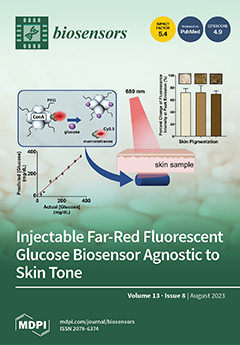With the popularization of intelligent sensing and the improvement of modern medical technology, intelligent medical sensing technology has emerged as the times require. This technology combines basic disciplines such as physics, mathematics, and materials with modern technologies such as semiconductors, integrated circuits, and
[...] Read more.
With the popularization of intelligent sensing and the improvement of modern medical technology, intelligent medical sensing technology has emerged as the times require. This technology combines basic disciplines such as physics, mathematics, and materials with modern technologies such as semiconductors, integrated circuits, and artificial intelligence, and has become one of the most promising in the medical field. The core of intelligent medical sensor technology is to make existing medical sensors intelligent, portable, and wearable with full consideration of ergonomics and sensor power consumption issues in order to conform to the current trends in cloud medicine, personalized medicine, and health monitoring. With the development of automation and intelligence in measurement and control systems, it is required that sensors have high accuracy, reliability, and stability, as well as certain data processing capabilities, self-checking, self-calibration, and self-compensation, while traditional medical sensors cannot meet such requirements. In addition, to manufacture high-performance sensors, it is also difficult to improve the material process alone, and it is necessary to combine computer technology with sensor technology to make up for its performance shortcomings. Intelligent medical sensing technology combines medical sensors with microprocessors to produce powerful intelligent medical sensors. Based on the original sensor functions, intelligent medical sensors also have functions such as self-compensation, self-calibration, self-diagnosis, numerical processing, two-way communication, information storage, and digital output. This review focuses on the application of intelligent medical sensing technology in biomedical sensing detection from three aspects: physical sensor, chemical sensor, and biosensor.
Full article
 to open them.
to open them.





